| IN
THIS ISSUE . . .
November 25, 2008
Director's Message
Advisory Council Concept Clearances
Funding Opportunities
Research Administration Notes
Resources
The NIGMS Feedback Loop e-mail newsletter alerts
researchers to NIGMS funding
opportunities, trends, and plans. NIGMS grantees and
recent applicants are automatically subscribed; we encourage
other interested individuals to subscribe themselves.
To subscribe, change your subscription options, or unsubscribe,
visit the NIGMS Feedback Loop subscription
page on the NIH LISTSERV Web site.
What information would you like to see in future issues?
Send your ideas to NIGMS Feedback Loop coordinator
James Deatherage (301-594-0828, deatherj@nigms.nih.gov).
Director's Message
The period since the publication of the last NIGMS Feedback Loop has been tremendously active. This has been due, in part, to the expectation that NIH Director Elias A. Zerhouni, M.D., would submit his resignation prior to the change in administration. Indeed, Dr. Zerhouni did step down on October 31, ending a period of approximately 6 1/2 years at the helm of NIH. In my opinion, Dr. Zerhouni was a remarkable director, leading NIH through some very challenging times and tackling some truly fundamental issues. His deeply analytical and creative contributions will be missed. Raynard Kington, M.D., Ph.D., formerly the principal Deputy Director of NIH, has been appointed Acting Director. Dr. Kington has been involved in all aspects of NIH operations and leadership, and I am confident that he will serve ably.
In this message, I would like to bring you up to date on two activities that have recently reached key implementation stages. I also present an update on the budget, note some of our discussions on workforce planning and diversity, congratulate grantees on their Nobel Prize, and introduce a new feature of the NIGMS Feedback Loop.
New and Early-Stage Investigators
One activity near implementation involves policies regarding new and early-stage investigators. There are several important reasons for this focus. First, the age distribution of the biomedical workforce, including the principal investigators (PIs) of NIH research project grants (RPGs), has changed dramatically.
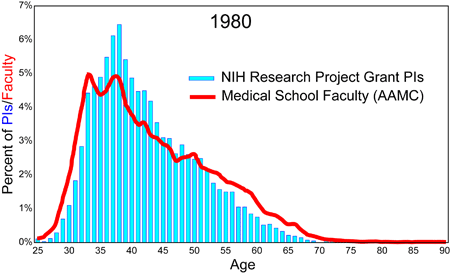 |
| Figure 1. Comparison of age distributions for PIs on NIH RPGs and faculty at medical schools in 1980. |
Figure 1 shows the age distribution for PIs for all NIH RPGs and the age distribution for medical school faculty (provided by the American Association of Medical Colleges [AAMC]). The two distributions overlap substantially and show significant numbers of investigators younger than 40.
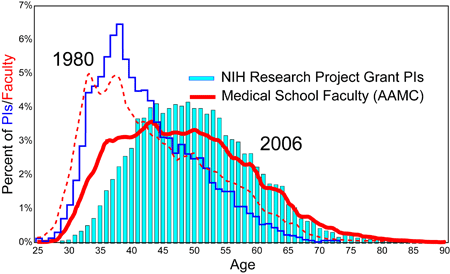 |
| Figure 2. Comparison of the age distributions for PIs on NIH RPGs and faculty at medical schools in 1980 and 2006. |
These distributions had changed dramatically by 2006, broadening and shifting toward higher ages. In addition, a substantial gap is present between the age of medical school faculty appointment and the age of successful competition for a research grant. A PowerPoint presentation of the age distribution from 1980 through 2006 is available from the NIH Office of Extramural Research. NIH has been developing several computer models that suggest that, in the absence of changes within the biomedical workforce system, these trends will continue over the next several decades.
The second reason to concentrate on new and early-stage investigators is that the number of R01 grants to new NIH PIs (defined as individuals who have not received a substantial grant from NIH in the past) typically declines during periods of highly constrained budgets.
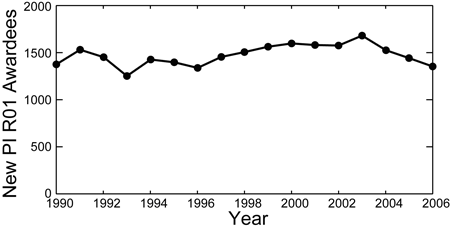 |
| Figure 3. Number of new NIH PI R01 awardees from 1990 through 2006. Note the decrease in the number of awardees from 1,680 to 1,354 over the period from 2003 to 2006. |
This pattern became clear in Fiscal Year 2006. The number of R01 grants going to new PIs had dropped for 3 years, falling below historical averages. To address this trend, NIH set a goal of funding enough grants to new PIs to reach the historical average within each institute and center. This resulted in a total of 1,596 new PIs receiving R01 grants in Fiscal Year 2007. The policy was continued in Fiscal Year 2008, resulting in the funding of 1,684 new PIs.
Recently, this policy has been refined. It sets the expectation for NIH overall and for each institute and center to maintain at least the same R01 success rate for new PIs as for established investigators submitting new (as opposed to resubmission, formally competing renewal) R01 applications. NIH anticipates that this policy will permit it to fund 1,650 or more new PIs in Fiscal Year 2009, a number comparable to that for Fiscal Year 2008.
In addition, NIH staff have examined the characteristics of the new PI pool. While some of these new PIs are just initiating their independent careers, others have been independent and active in research for some time but have been supported by other agencies (e.g., the National Science Foundation and the Department of Veterans Affairs). To focus attention on those investigators who are just initiating their independent careers, NIH developed a definition of an early-stage investigator (ESI). As defined, ESIs are new investigators who completed a terminal research degree (typically a Ph.D. or M.D.) or a residency within the last 10 years. An estimate based on sampling shows that approximately 55% of new NIH investigators met the ESI definition in Fiscal Year 2007. In the future, NIH will modify data collected on degree dates and medical residency in investigators’ personal profiles on the eRA Commons. This will allow more accurate tracking of ESI success rates and will facilitate increasing the fraction of ESIs within the funded new investigator pool. For Fiscal Year 2009, because most grant applications already have been submitted, ESIs will be identified using available information in the applications, primarily the biosketch.
Although each NIH institute and center is encouraged to have an average RPG award duration of 4.0 years, NIGMS has a policy of providing 5 years of support to ESIs whenever possible. For this reason, we urge ESIs to request 5 years when appropriate.
Enhancing Peer Review
Much of the analysis and the policy changes regarding new and early-stage investigators came out of the NIH Enhancing Peer Review effort. Many additional initiatives from this effort are now reaching the implementation stage. A striking finding from the Enhancing Peer Review analysis relates to dramatic changes in the distribution of unamended (A0), first (A1), and second (A2) applications within the pool of funded R01 grants.
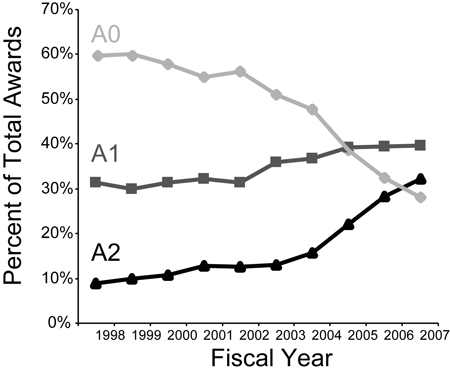 |
| Figure 4. The fraction of A0 (new, unamended), A1, and A2 applications within the pool of funded R01 grants for the Fiscal Years 1997-2007. Note the dramatic decrease in the pool of A0 applications from approximately 60% to less than 30%. |
I had noted this trend in my November 2006 Director’s message. The trend has resulted in a significant decrease in the success rate for unamended (A0) R01 (and equivalent) applications across NIH from 18.8% for Fiscal Year 2004 to 12.1% in Fiscal Year 2007, even though the overall R01 success rates were fairly similar (25.5% for 2004 and 23.6% for 2007). This situation has led to a substantial increase in the average number of times that an application had to be submitted before it was funded, even if the application scored reasonably well when it was first submitted as an A0.
To change this trend and increase the likelihood that meritorious applications will be funded, NIH recently introduced a new policy decreasing the number of allowed amendments. Beginning with applications submitted for the January 25, 2009, due date, NIH will accept only a single amendment (A1) to the original (A0) application. Applications submitted prior to that time will be allowed two amendments (up to A2) as necessary. This policy applies to all applications and all mechanisms. For all applicants, especially new and early-stage investigators, this change in policy reinforces the value of having colleagues review applications and provide critical comments and suggestions prior to submission.
Other aspects of the Enhancing Peer Review initiative are approaching implementation. These include efforts related to reviewer recruitment, retention, and training; application scoring; critique structure; and application lengths. They are described at the Enhancing Peer Review Implementation Updates and Preparing for Changes in Peer Review Web sites. Check the Enhancing Peer Review Web site periodically for the most current information.
Outcomes and Budget Planning
Fiscal Year 2008 ended on September 30. As I noted in the March 2008 and July 2008 issues of the NIGMS Feedback Loop, the appropriation for Fiscal Year 2008 was unchanged from Fiscal Year 2007 except for approximately $10 million provided within a supplemental funding bill enacted on June 30. The results of this funding for R01 grants are shown in Figures 5 and 6 below.
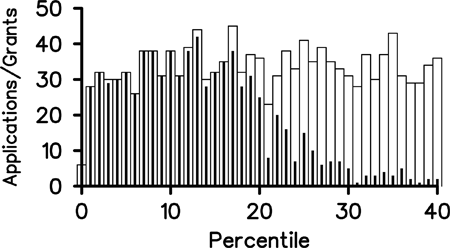 |
| Figure 5. NIGMS R01 applications reviewed (white rectangles) and funded (black bars) in Fiscal Year 2008. All competing applications are included. |
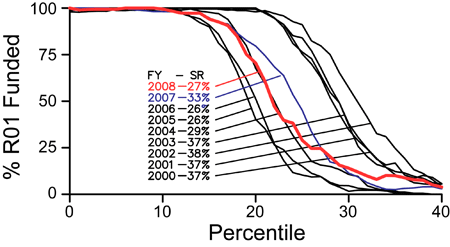 |
| Figure 6. NIGMS funding curves for Fiscal Years 2000-2008, including all competing R01 grant applications. |
The overall R01 success rate for Fiscal Year 2008 was approximately 27%. This is higher than the 22% success rate we had projected previously for two main reasons. First, the number of R01 grants that we were able to fund slightly increased due to the supplemental funding provided in June. In addition, we received a slightly lower number of applications than projected. The decrease in success rate compared to Fiscal Year 2007 is primarily due to two factors: a smaller budget increase for Fiscal Year 2008 and the funding of more noncompeting continuation R01 grants due to the relatively large number of competing R01 grants we were able to fund in Fiscal Year 2007 (see the November 2007 NIGMS Feedback Loop).
We are preparing additional data on NIGMS funding trends and will be posting it on the NIGMS Web site at http://www.nigms.nih.gov/research/application/trends.
The budget situation for Fiscal Year 2009 has not yet been resolved. We are currently operating under a continuing resolution that extends until March 6, 2009, and provides funding at the same level as Fiscal Year 2008 (excluding supplemental funds). There have been reports that Congress is considering the inclusion of additional funding for NIH as part of economic stimulus packages and that it plans to introduce an omnibus appropriation bill early in the new administration, but no such actions have been taken at this point.
Workforce Planning and Diversity
One of the major goals within the NIGMS Strategic Plan is to “identify innovative approaches among individuals and institutions to foster training and the development of an inclusive and effective scientific workforce.” NIGMS staff have been engaged in many productive discussions about this goal, both among ourselves and with members of the broad scientific community. Additionally, NIH recently hosted a lecture by Dr. Freeman Hrabowski, President of the University of Maryland, Baltimore County, and a leader in science education, training, and diversity programs. I strongly recommend viewing his talk, which begins about 20 minutes into the videocast.
Nobel Prize for NIGMS Grantees
The Nobel Prize in chemistry was awarded to Osamu Shimomura, Martin Chalfie, and Roger Tsien “for the discovery and development of green fluorescent protein, GFP.” All three have been supported by NIGMS at some stage of their careers and have also received support from other sources, including the National Science Foundation and the Howard Hughes Medical Institute. I posted a Commentary on Google News to highlight the role of various funding agencies in making such important research possible. The impact of this work on many aspects of biomedical and chemical research has been tremendous, and we congratulate the scientists for this important recognition of their contributions.
“Side Reactions”
In this issue of the NIGMS Feedback Loop, we are initiating a new section, “Side Reactions,” to address “urban legends” or other misinformation that we at NIGMS often hear. Here is the inaugural one, which relates to the relative probability of having R21 applications funded.
I often hear investigators say that they have an exciting project for which they are seeking support and that they are going to submit an R21 rather than an R01 application since their chances of obtaining funding are better. The R21 mechanism is used for a variety of purposes across NIH. R21 grants are typically 2 years in length with an overall direct-cost budget of $175,000 over the 2-year period. It seems to make intuitive sense that a smaller, shorter duration grant would be easier to obtain. However, data regarding R21 applications and awards across NIH reveal a different result.
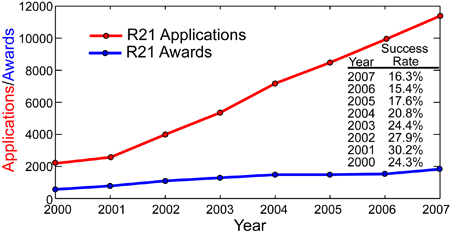 |
| Figure 7. The number of R21 applications and awards across NIH for Fiscal Years 2000-2007. The corresponding success rates are also shown. |
For Fiscal Year 2007, NIH received over 11,000 R21 applications—more than double the number received in Fiscal Year 2003. For 2007, the success rate for R21 applications was 16.3% compared with a 23.2% NIH-wide 2007 success rate for R01 applications. Indeed, over the period from 2000-2007, the success rate for R21 applications has always been lower than the success rate for R01 applications by an average of 4.5%.
The R21 mechanism is used to support research efforts where relatively modest funding over a relatively short period could be highly beneficial. NIGMS previously had an R21 program directed toward relatively high risk and potentially high impact research but discontinued it because of concerns about the challenges of reviewing such applications in the context of standing study sections and because of the limitations imposed by the relatively short duration of the awards. The funds that had gone to support this program were used to seed the EUREKA (Exceptional, Unconventional Research Enabling Knowledge Acceleration) R01 program. NIGMS does occasionally participate in targeted programs that utilize the R21 mechanism for specific purposes.
We urge all investigators, particularly new and early-stage investigators, to utilize the R01 mechanism under most circumstances. The R01 mechanism is very flexible in terms of budget, duration, and the inclusion of multiple PIs. Indeed, NIH has recently issued a notice encouraging early-stage investigators to apply for R01 grants rather than R21 and R03 grants whenever appropriate. And as I noted above, we also strongly encourage early-stage investigators to request 5 years of support for their initial R01 applications when appropriate.
I wish you a happy and healthy holiday season and, as always, I welcome your comments.
Best,
Jeremy M. Berg
Director
National Institute of General Medical Sciences
bergj@mail.nih.gov
Advisory Council Concept Clearances
Joint NIH/NSF Program for Instrument Development
The Council approved a joint research project grant program between NIGMS and the Division of Chemistry at the National Science Foundation to promote the development of innovative instruments and tools for chemical and biomedical research. We expect a program announcement early in 2009. Address any comments or questions to Program Director Charles Edmonds at 301-594-0828 or edmondsc@nigms.nih.gov.
Funding Opportunities
Short Courses on Mathematical, Statistical, and Computational Tools for Studying Biological Systems (R25)
NIGMS and other NIH components have issued a funding opportunity announcement to support workshops and short courses that improve the integration of mathematical, statistical, and computational approaches into biological and/or behavioral research. Support is limited to activities that reach a wide scientific audience and is not intended for university course or curriculum development. For details, see PA-09-002 or contact NIGMS Program Director Matthew Portnoy at 301-594-0943 or mportnoy@nigms.nih.gov.
Administrative Supplements for Collaborative Science
NIGMS grantees who have an R01, R37, or SC1 grant may apply for an administrative supplement to support new collaborations that further the aims of the funded grant. Investigators should contact their program director to discuss the proposed project before submitting an application. The complete announcement details eligibility, scope, application procedures, and deadlines—the first is December 15, 2008. We expect to fund up to 15 supplements in Fiscal Year 2009. For general information about the program, contact Program Directors Susan Haynes (hayness@nigms.nih.gov) or Marion Zatz (zatzm@nigms.nih.gov), or call 301-594-0943.
Administrative Supplements for Induced Pluripotent Stem Cell Research
NIGMS grantees may apply for Administrative Supplements for Induced Pluripotent Stem Cell Research (NOT-GM-08-136) for up to $75,000 in direct costs for 1 year. Proposed studies must be related to the aims of the parent grant, which must have at least 1 year of funding remaining at the time of supplement award. We strongly encourage grantees to contact their program director to discuss eligibility and suitability of the proposed studies before submitting an application for the April 1, 2009, deadline.
Metals in Medicine (R01)
NIGMS has reissued an announcement to encourage research that bridges inorganic chemistry and medicine (PA-08-251). The NIGMS scientific contact is Program Director Miles Fabian at 301-594-3827 or fabianm@nigms.nih.gov.
Roadmap Transformative R01 Program (R01)
The NIH Roadmap for Medical Research has a new Transformative R01 program (RFA-RM-08-029) to support exceptionally innovative research with the potential to create new scientific paradigms or challenge existing ones, regardless of the anticipated risk. The deadline for letters of intent is December 29, 2008, with applications due 1 month later. Other new Roadmap funding opportunities are also available. Direct questions to Kristin Abraham in the Office of Portfolio Analysis and Strategic Initiatives at 301-594-8190 or T_R01@mail.nih.gov.
2009 Director's Pioneer and New Innovator Awards (X02)
NIH welcomes proposals for the 2009 NIH Director's Pioneer Award and New Innovator Award. Both programs support exceptionally creative scientists who take highly innovative, potentially high-impact approaches to major challenges in biomedical or behavioral research. Pioneer Awards provide up to $2.5 million in direct costs over 5 years and are open to scientists at any career stage. New Innovator Awards provide up to $1.5 million in direct costs over the same period and are for early career investigators who have not received an NIH regular research (R01) or similar NIH grant. NIH expects to make 5 to 10 Pioneer Awards and up to 24 New Innovator Awards in September 2009.
Starting this year, both the Pioneer Award and the New Innovator Award process will begin with a pre-application phase. For Pioneer Award pre-application details, see PAR-09-012. For the New Innovator Award, see PAR-09-013.
NIH Roadmap Molecular Libraries and Imaging Initiative RFI
NIH is requesting information from researchers in chemical genomics to reveal gaps and help identify specific, achievable goals that will advance and transform the field through the NIH Roadmap Molecular Libraries Screening/Production Centers Network and PubChem. Responses must be submitted electronically via Survey Monkey by December 21, 2008, and can be made anonymously. Specific questions should be directed to Scott W. Jackson in the Office of the Director at 301-496-9123 or jacksonsc@mail.nih.gov.
Research Administration Notes
Adobe Forms and Electronic Grant Submission
Starting in 2009, most electronic NIH grant submissions must use Adobe forms. We strongly recommend that you review Resources for Adobe Transition to see the current transition schedule and also to avoid any delays or issues with submitting your applications.
For a list of grant programs to transition to electronic submission, see the timeline.
New NIH Policy on Resubmission (Amended) Applications
In the last few years, an increasing portion of R01 awards have been made to applications on their second revision (A2). To increase the likelihood that meritorious original applications will be funded and to reduce the burden on reviewers, NIH will decrease the number of amendments. As of the January 25, 2009, due date, all original applications will be permitted only a single amendment (see NOT-OD-09-003). This and other changes to NIH peer review are discussed in the Director's message.
Supporting More Than One Position by Research Supplements to Promote Diversity
In accordance with NOT-GM-08-127, NIGMS will consider supporting more than one graduate student or postdoctoral fellow on a grant when requests are made in response to Research Supplements to Promote Diversity in Health-Related Research (PA-08-190), a program designed to recruit and support individuals from underrepresented groups. We encourage you to contact your NIGMS program director and Program Coordinator John Whitmarsh at 301-451-6446 or whitmarj@nigms.nih.gov before applying.
Resources
A Gateway to Proteins
Interested in proteins? Visit the PSI Structural Genomics Knowledgebase, now offered in collaboration with Nature Publishing Group. This "Gateway" site is a continually updated portal to PSI data and resources, events, and funding opportunities. It also offers articles and editorials that make recent research findings and technological innovations in structural biology and structural genomics accessible to the broader scientific community.
Financial Conflict of Interest Online Tutorial
NIH offers a Web-based tutorial to improve and enhance compliance with its financial conflict of interest requirements. The tutorial is designed for researchers and institutional officials responsible for grant administration.
New Recruitment Tool
NIH and 18 other leading higher education and research institutions announced the launch of the Mid-Atlantic Higher Education Recruitment Consortium. Like its counterparts in other regions, HERC offers a Web-based listing of faculty and staff job opportunities at all member institutions. It also assists with dual-career searches. |